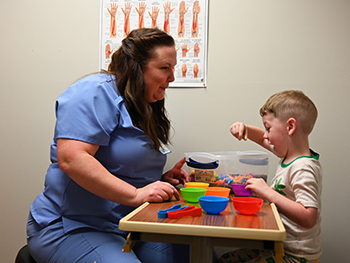
Photo of female occupational therapist working on sensory activity with 4-year-old boy.
Pediatric patients make strides through personal occupational therapy connection
Two minutes is all it takes for a connection to be made.
As the seconds slowly tick away on the square timer sitting next to him, 4-year-old Sam Jones molds the clay in his tiny hands. First a ball, it quickly becomes a rock for a dump truck and then spills out onto the table where it is quickly stretched into a tangled web.
It may seem like an ordinary playtime activity; but for Sam, it’s so much more than that. It’s an opportunity to work on fine motor coordination, sensory processing and self-regulation in a safe and nurturing environment.
Sam has been attending occupational therapy at Ashe Memorial Hospital twice a week for more than a year to help with Apraxia, a neurological condition that affects motor planning.
“We love Miss Kate (Brosell),” Sam’s mother, Cheryl Jones says. “They genuinely care about Sam and are just so good with him. We’re lucky to be in therapy with Miss Kate. Sam’s a good kid, and he’s making a lot of progress.”
Kate always knew that she wanted to work with children. She earned her bachelor’s degree in psychology from the University of North Carolina at Wilmington in 2004. After helping run children’s group therapy for the Open Gate Domestic Violence Shelter, Kate earned her master’s degree in occupational therapy from the University of New England Portland Campus for the Health Sciences in 2013.
After spending seven years as an occupational therapist for New Hanover City Schools, Covid happened, and Kate began seeing students and their families outside of school.
“It felt very personal with the families,” Kate says. “It got my wheels turning. There’s more than you can do outside of school, and I find it so much more rewarding.”
Kate joined the team at Ashe Memorial Hospital in 2021 where she primarily works with pediatric patients. Each therapy session is different and is tailored to meet the needs of the patient. Pediatric occupational therapy is often centered around play, which can look different for each child. Kate tries to incorporate various aspects of play, including building, drawing, coloring, cutting with scissors, dressing up toys, movement, sensory bins and water play, among others, into each session.
“I love it,” Kate says. “I meet the kids and families wherever they are, and we build upon those skills whether it’s dressing themselves, feeding, play or overcoming sensory challenges.”
While Kate enjoys seeing the progress that each child makes during his or her session, it’s watching them grow outside of therapy and being able to participate in events and activities that they may not otherwise have been able to do that are the most rewarding.
“I worked with a girl that was in high school with sensory challenges, and she went to a concert,” Kate says. “We try to find ways for kids of all ages to do what other kids are doing. They went as a family, and it was just huge for her to be able to participate with all the noise, movement and people. It was awesome because that’s what she should be doing at that age.”
Occupational therapy can be used to treat children who may not be meeting milestones, display different motor or social skills, have trouble regulating themselves or experience sensory or behavioral challenges because of underlying conditions such as autism or ADHD.
Additionally, Kate works closely with speech therapy and physical therapy as some of her patients, such as Sam who also attends speech therapy, may utilize multiple rehabilitation service offerings.
“That’s kind of what occupational therapy is all about,” Kate says. “We look at the whole person and make sure that all of their needs are met.”
For more information on occupational therapy or to schedule an appointment, please call 336-846-0833.



